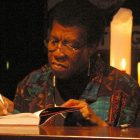Theresa Hak Kyung Cha’s Disruption of Language

On the back cover of Exilée and Temps Morts: Selected Works, the University of California Press gives readers a brief write-up of Theresa Hak Kyung Cha’s biographic information: “Theresa Hak Kyung Cha was born in 1951 in Pusan, Korea, and moved with her family to the United States at the age of eleven,” it reads. “She received bachelor’s and master’s degrees from the University of California, Berkeley, and did postgraduate work in Paris. In 1982, a stranger murdered Cha in New York City, just a few days after the original publication of Dictée.” These facts come together in our minds to form a certain picture of Cha’s life. We have some familiarity with biography as a literary form, and because we understand the meaning of those sentences, we therefore assume we understand something about the meaning of Cha herself. It would be a mistake, however, to think that the literary conventions familiar to us in biography or autobiography (for instance, the accrual of historical facts or realistic descriptions of experience) are always the forms best suited to representing the multiple and conflicting valences of a complex human being.
Exilée and Temps Morts is a selection of Cha’s uncollected and unpublished work, and serves to give readers “a fuller view of the creative nexus out of which Dictée emerged.” Dictée itself is considered to be a classic postmodern work of autobiography and operates in a mode contrary to that of traditional autobiography by resisting easy communication with its reader. This difficulty of communication illustrates the instability and contradiction Cha saw in the roles she inhabited as a woman, as a Korean emigrant, and as a U.S. citizen. Cha understood herself as a series of multiple, fragmented identities, the makeup of which was constantly in flux, and which could not be fully or accurately articulated using the crude tools of language.
Cha seemed intimately aware of the demand readers make of a kind of access to the (often painful) experiences of personal history, memory, and identity—especially if the writer is coded as “other.” The scholar Elaine H. Kim notes in Writing Self, Writing Nation (1994), “If Korean history is missing from the master narratives of the West and women are absent from recorded Korean history, the Korean American woman is invisible in both discourses.” Marginalized authors often shoulder a burden of representation, writing about their identities in ways that conform to conventional reading practices, which precludes them from writing in more difficult or experimental ways. In Writing Self, Writing Nation, the scholar L. Hyun Yi Kang argues that there are “contradictory impulses and pressures of representation.” “To be a speaking subject,” writes Kang, “means also that one presents oneself to the other’s scrutiny and (mis)interpretation.” A subject may find, for example, that they have to perform their identity in ways that, though they may not be completely accurate, are already familiar to their audience. What is familiar to an audience can therefore become intelligible. Cha seems to acknowledge this contradictory impulse when she writes, “what if / i say / this / in saying that / for lack of a better word / for the heart of the matter is / that / if i should / say / none the less / in a way / in such a way / that would / that could / suggest / in other words / none less than / another possibility / an other way / one other possible way / only one way possible / the only other way possible / by that / meaning / it is already / said / being said / all along.” Language often falls short of corresponding directly to identity, so Cha selected images to accompany her writing and considered herself as much a visual artist as a writer.
The inherent contradictions Cha saw in herself resulted in syntactically challenging and formally experimental writing. Kang describes her own difficulty reading Cha the first time she encountered the artist’s work:
My biggest frustration was what I perceived of as the ‘slipperiness’ of the book. It angered me that the text was not accessible, that it seemed to speak to a highly literate, theoretically sophisticated audience that I did not identify with. Most of all, Cha herself remained elusive. I could not have begun to see the many other possibilities of the book until I was able to first explore and unravel this crisis of inaccessibility/incomprehension. Subsequent readings and other illuminating experiences enabled me to understand this anger and frustration as stemming from my own narrow, fixed and rather homogenous definitions of Korean/American identity and collective experience. I believed that I, as a Korean/American woman, should be able to immediately understand and identify with the work of another Korean/American woman, and since that instant mirroring/attraction did not happen, either there must be something ‘wrong’ with me or with her. However, I came to see that initial slipperiness revolved around the very notions of language that I struggle with.
A native speaker of a language assumes they have some sort of mastery over that language. When fluency is interrupted, that feeling of mastery is destabilized and frustrates a reader’s attempt to make sense of what they are reading. Language has become defamiliarized, and so a reader must proceed slowly and critically in their search for meaning rather than read at their normal, faster, subconscious level. Traditional autobiography (and, in fact, much of literature) allows for the language-fluent side of our brains to take over and reading functions as a process of consuming the given words and extracting their familiar meanings. Words become semantic windows; the material text dissolves away and a reader is transported to the picture actively painted in their minds by language. These processes of consumption and extraction are often made invisible to us by our “mastery” of language and conventional modes of reading that assume meaning can be extracted in a unified, complete sense. It is not a far stretch therefore to speak of the violence this kind of extractive reading evokes when those words are presented as a record of a person’s life. Writing that instead attempts to resist conventional reading practices, however, often runs the risk of being dismissed altogether by readers as nonsense.
By resisting aesthetic qualities such as a singular, unified meaning, or a correspondence between language and the world that privileges realism, Cha embraces an aesthetics of opacity. Opacity resists reader interpretation that ties language to expression in rigid, communicative ways. Because of this, critics often dismiss opaque writing as emotionally cold, and although clever, an ultimately unnecessary formal experiment. Opacity, however, is an aesthetic of performance, more like abstract art, in which interpretive boundaries become much looser. Cha uses opacity to perform an excess of psychic distress and emotion—her writing is anything but cold, and it points to the value of a phenomenology of opacity as a way to take the measure of one’s self. Toward the beginning of Dictée, Cha writes, “Inside is the pain of speech the pain to say. Larger still. Greater than is the pain not to say. To not say. Say nothing against the pain to speak.” How does one say the unspeakable? It must be painful indeed to attempt to articulate the self through the crude tools of language; more painful still to be forced into silence by their brokenness.
Our current historical moment has seen an increased interest in so-called identity politics and the value of representation in culture. Cha challenges the notion that marginalized groups have an obligation to make their personal histories, memories, and identities accessible and known through writing practices that privilege conventional modes of expression. Toward the beginning of Exilée and Temps Morts, in a poem titled “audience distant relative,” Cha writes, “i address you” even though “neither you nor i / are visible to each other.” The emphasis of the pronouns “i” and “you” makes this a poem of person deixis, in which the reader becomes primarily concerned with identifying the participant roles in the poem: who is the “i” speaker and who is the “you” addressee? These roles are extralinguistic to the poem; the “i” is only known by its relationship to the “you.” Cha writes, “i address you / as i would a distant relative / seen only heard only through someone else’s description.” Similarly, in “object/subject,” Cha emphasizes the relationship between “i” and “you”: “in our relationship / i am the object/you are the subject / in our relationship / you are the object/i am the subject / in our relationship / you are the subject/i am the object / in our relationship / i am the subject/you are the object.”
Like Kang, I had my own difficulty reading Cha. At first, I assumed (as I often do) that the “i” speaker of Cha’s poem is Cha herself, and as the poem was originally written/read, I suppose this must have been true. But now, in the specific and unique voicing of my own reading of the poem, the relationship between “i” and “you” has become inverted: “i” (me, the reader) address “you” (an other/audience/not me). I am the speaking subject that says “i.” Cha presents language in a way that is assumed into use by the individual, rather than language as a system of communicative signs; “i” and “you” cannot point anywhere outside of the poem, only at one another. Is Cha then saying that the “audience” of the poem is like a “distant relative,” in that the “you” and the “i” are relational in this way? Or is Cha saying that the distance between audiences is relative, since the appropriation of the “i” by the speaker establishes a discourse in which they take over all the resources of language for their own behalf? “You” are always the audience because “i” am always the speaking subject that says “i.” Cha’s last two lines of “audience distant relative” read: “i can only assume that you can hear me / i can only hope that you hear me.” An audience is always composed of people we do not necessarily know and who only need to give us their glancing attention. An audience is also always at least partially imaginary, “seen only heard only through someone else’s description,” Cha might say, and so we therefore make assumptions about what this audience might expect of us in advance. We can only hope that we are heard by this simultaneously personal, impersonal, and imaginary audience of readers. And in doing so, we always risk their (mis)interpretation of us.



